Systems Thinking: Project Management, Organizational Structure
VerifiedAdded on 2023/06/12
|9
|2757
|259
Essay
AI Summary
This essay examines the significance of systems thinking in project management and organizational structure, drawing upon theories related to general systems management, organizational culture, engineering risk, portfolio alignment, business value, and organizational maturity. It analyzes how systems thinking tools and techniques can aid project managers in solving complex problems, referencing the Texas City refinery explosion and Deepwater Horizon oil spill as case studies. The essay emphasizes the importance of risk management, proactive planning, and adaptation to changing consumer needs to achieve organizational success and profitability. It concludes that effective management, strategic tool implementation, and a focus on consumer demands are crucial for any business organization aiming to thrive in a competitive market.
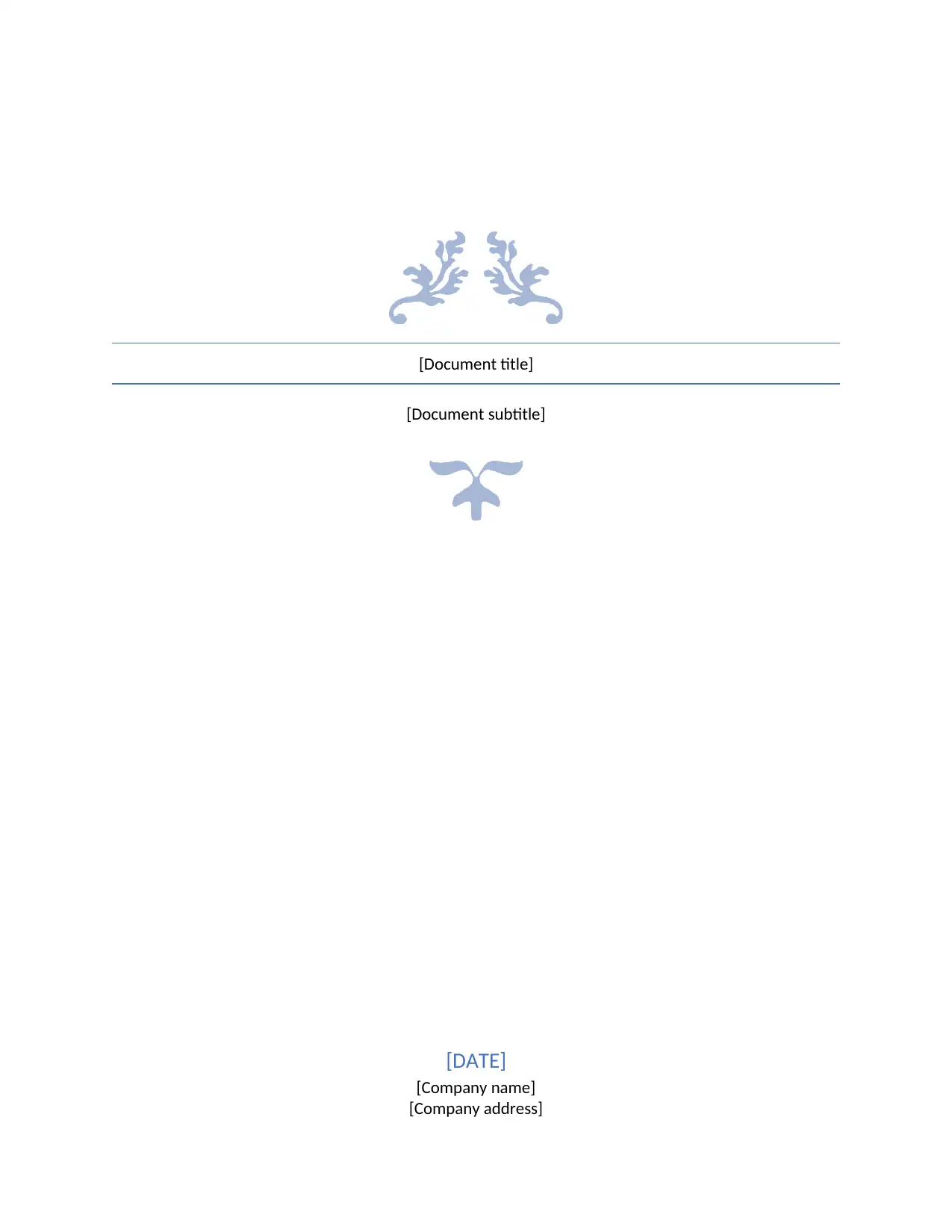
[Document title]
[Document subtitle]
[DATE]
[Company name]
[Company address]
[Document subtitle]
[DATE]
[Company name]
[Company address]
Paraphrase This Document
Need a fresh take? Get an instant paraphrase of this document with our AI Paraphraser

Table of Contents
Introduction:................................................................................................................................................2
Critical analysis:..........................................................................................................................................2
General systems management......................................................................................................................2
Organizational structure, forms and culture:................................................................................................3
Engineering risk, risk management:............................................................................................................4
Portfolio alignment:.....................................................................................................................................5
Business value:............................................................................................................................................5
Portfolio management process cycle:..........................................................................................................5
Organizational maturity:..............................................................................................................................6
Texas city and Deepwater Horizon oil spill.................................................................................................6
Conclusion:.................................................................................................................................................6
References...................................................................................................................................................7
1
Introduction:................................................................................................................................................2
Critical analysis:..........................................................................................................................................2
General systems management......................................................................................................................2
Organizational structure, forms and culture:................................................................................................3
Engineering risk, risk management:............................................................................................................4
Portfolio alignment:.....................................................................................................................................5
Business value:............................................................................................................................................5
Portfolio management process cycle:..........................................................................................................5
Organizational maturity:..............................................................................................................................6
Texas city and Deepwater Horizon oil spill.................................................................................................6
Conclusion:.................................................................................................................................................6
References...................................................................................................................................................7
1

Introduction:
This essay shows the significance of appropriate tool management in an organization. By using
proper theories and tools, the organizations can deliver satisfying and expected outcomes.
Different business organizations use different managerial tools that is based on the type of
process of business. The aim of this essay is to define and describe system thinking used to
classify different techniques and tools which are relevant to it.
This paper elaborates general system management, structure and culture of the organization,
business values and form of business organizations. It also describes portfolio alignment, risk
management approaches and engineering risks. Maturity of any business organization depends
on its management structure and culture. It also describes the process of portfolio management
process cycle.
Critical analysis:
General systems management
General systems management are generally used to obtain measurable revenue structure from
competitive market. It is different from traditional management system. To establish any small
business on the basis of traditional hierarchal structure, business organization needs to use
general systems theory (Johnston, n.d.). Top down approach is followed by the general
management structure in which, the top-level management is the boss who has all the leading
authority and other employees like managers and other subordinates are supposed to follow his
instructions. It also provides owner of organization with several beneficial way to reorganize the
company (Guide to the Systems Engineering Body of Knowledge (SEBoK), 2017). The business
model components involve goals, matrix of subsystem, project orientation, permanence and
transformation.
Goals:
Several goals can be achieved, even resolved and implemented by the organization under general
systems theory (Mel, Pels, & Polese, 2010). Each and ever department of the company set their
own goals and together they provide desired outcome for the customers or consumers of the
organization. However, they can also collaborate other departments in order to obtain certain
goals.
The matrix of the subsystems:
With the help of this theory, vertical system approach and bottom up approach can be formed. in
new formed structures each department will have e one owner and with the help of this process
the interrelationship among these departments can be illustrated (Kerzner, 2013). According to
this approach, every department of the organization which includes manufacturing, finance or
marketing department etc. can act as a main or leading department. However, these departments
can also exist according to the traditional hierarchy. If nay organization uses the general system
2
This essay shows the significance of appropriate tool management in an organization. By using
proper theories and tools, the organizations can deliver satisfying and expected outcomes.
Different business organizations use different managerial tools that is based on the type of
process of business. The aim of this essay is to define and describe system thinking used to
classify different techniques and tools which are relevant to it.
This paper elaborates general system management, structure and culture of the organization,
business values and form of business organizations. It also describes portfolio alignment, risk
management approaches and engineering risks. Maturity of any business organization depends
on its management structure and culture. It also describes the process of portfolio management
process cycle.
Critical analysis:
General systems management
General systems management are generally used to obtain measurable revenue structure from
competitive market. It is different from traditional management system. To establish any small
business on the basis of traditional hierarchal structure, business organization needs to use
general systems theory (Johnston, n.d.). Top down approach is followed by the general
management structure in which, the top-level management is the boss who has all the leading
authority and other employees like managers and other subordinates are supposed to follow his
instructions. It also provides owner of organization with several beneficial way to reorganize the
company (Guide to the Systems Engineering Body of Knowledge (SEBoK), 2017). The business
model components involve goals, matrix of subsystem, project orientation, permanence and
transformation.
Goals:
Several goals can be achieved, even resolved and implemented by the organization under general
systems theory (Mel, Pels, & Polese, 2010). Each and ever department of the company set their
own goals and together they provide desired outcome for the customers or consumers of the
organization. However, they can also collaborate other departments in order to obtain certain
goals.
The matrix of the subsystems:
With the help of this theory, vertical system approach and bottom up approach can be formed. in
new formed structures each department will have e one owner and with the help of this process
the interrelationship among these departments can be illustrated (Kerzner, 2013). According to
this approach, every department of the organization which includes manufacturing, finance or
marketing department etc. can act as a main or leading department. However, these departments
can also exist according to the traditional hierarchy. If nay organization uses the general system
2
⊘ This is a preview!⊘
Do you want full access?
Subscribe today to unlock all pages.

Trusted by 1+ million students worldwide
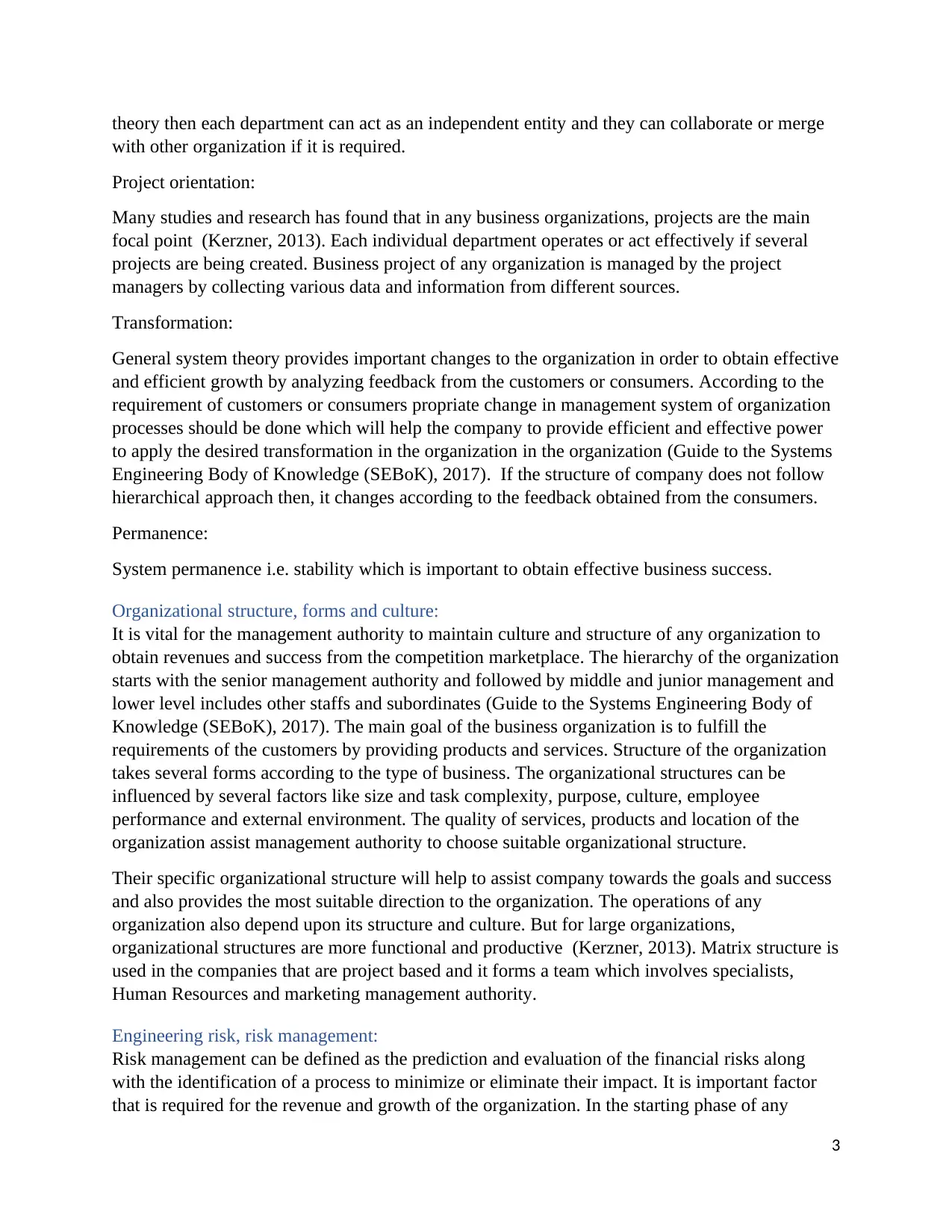
theory then each department can act as an independent entity and they can collaborate or merge
with other organization if it is required.
Project orientation:
Many studies and research has found that in any business organizations, projects are the main
focal point (Kerzner, 2013). Each individual department operates or act effectively if several
projects are being created. Business project of any organization is managed by the project
managers by collecting various data and information from different sources.
Transformation:
General system theory provides important changes to the organization in order to obtain effective
and efficient growth by analyzing feedback from the customers or consumers. According to the
requirement of customers or consumers propriate change in management system of organization
processes should be done which will help the company to provide efficient and effective power
to apply the desired transformation in the organization in the organization (Guide to the Systems
Engineering Body of Knowledge (SEBoK), 2017). If the structure of company does not follow
hierarchical approach then, it changes according to the feedback obtained from the consumers.
Permanence:
System permanence i.e. stability which is important to obtain effective business success.
Organizational structure, forms and culture:
It is vital for the management authority to maintain culture and structure of any organization to
obtain revenues and success from the competition marketplace. The hierarchy of the organization
starts with the senior management authority and followed by middle and junior management and
lower level includes other staffs and subordinates (Guide to the Systems Engineering Body of
Knowledge (SEBoK), 2017). The main goal of the business organization is to fulfill the
requirements of the customers by providing products and services. Structure of the organization
takes several forms according to the type of business. The organizational structures can be
influenced by several factors like size and task complexity, purpose, culture, employee
performance and external environment. The quality of services, products and location of the
organization assist management authority to choose suitable organizational structure.
Their specific organizational structure will help to assist company towards the goals and success
and also provides the most suitable direction to the organization. The operations of any
organization also depend upon its structure and culture. But for large organizations,
organizational structures are more functional and productive (Kerzner, 2013). Matrix structure is
used in the companies that are project based and it forms a team which involves specialists,
Human Resources and marketing management authority.
Engineering risk, risk management:
Risk management can be defined as the prediction and evaluation of the financial risks along
with the identification of a process to minimize or eliminate their impact. It is important factor
that is required for the revenue and growth of the organization. In the starting phase of any
3
with other organization if it is required.
Project orientation:
Many studies and research has found that in any business organizations, projects are the main
focal point (Kerzner, 2013). Each individual department operates or act effectively if several
projects are being created. Business project of any organization is managed by the project
managers by collecting various data and information from different sources.
Transformation:
General system theory provides important changes to the organization in order to obtain effective
and efficient growth by analyzing feedback from the customers or consumers. According to the
requirement of customers or consumers propriate change in management system of organization
processes should be done which will help the company to provide efficient and effective power
to apply the desired transformation in the organization in the organization (Guide to the Systems
Engineering Body of Knowledge (SEBoK), 2017). If the structure of company does not follow
hierarchical approach then, it changes according to the feedback obtained from the consumers.
Permanence:
System permanence i.e. stability which is important to obtain effective business success.
Organizational structure, forms and culture:
It is vital for the management authority to maintain culture and structure of any organization to
obtain revenues and success from the competition marketplace. The hierarchy of the organization
starts with the senior management authority and followed by middle and junior management and
lower level includes other staffs and subordinates (Guide to the Systems Engineering Body of
Knowledge (SEBoK), 2017). The main goal of the business organization is to fulfill the
requirements of the customers by providing products and services. Structure of the organization
takes several forms according to the type of business. The organizational structures can be
influenced by several factors like size and task complexity, purpose, culture, employee
performance and external environment. The quality of services, products and location of the
organization assist management authority to choose suitable organizational structure.
Their specific organizational structure will help to assist company towards the goals and success
and also provides the most suitable direction to the organization. The operations of any
organization also depend upon its structure and culture. But for large organizations,
organizational structures are more functional and productive (Kerzner, 2013). Matrix structure is
used in the companies that are project based and it forms a team which involves specialists,
Human Resources and marketing management authority.
Engineering risk, risk management:
Risk management can be defined as the prediction and evaluation of the financial risks along
with the identification of a process to minimize or eliminate their impact. It is important factor
that is required for the revenue and growth of the organization. In the starting phase of any
3
Paraphrase This Document
Need a fresh take? Get an instant paraphrase of this document with our AI Paraphraser
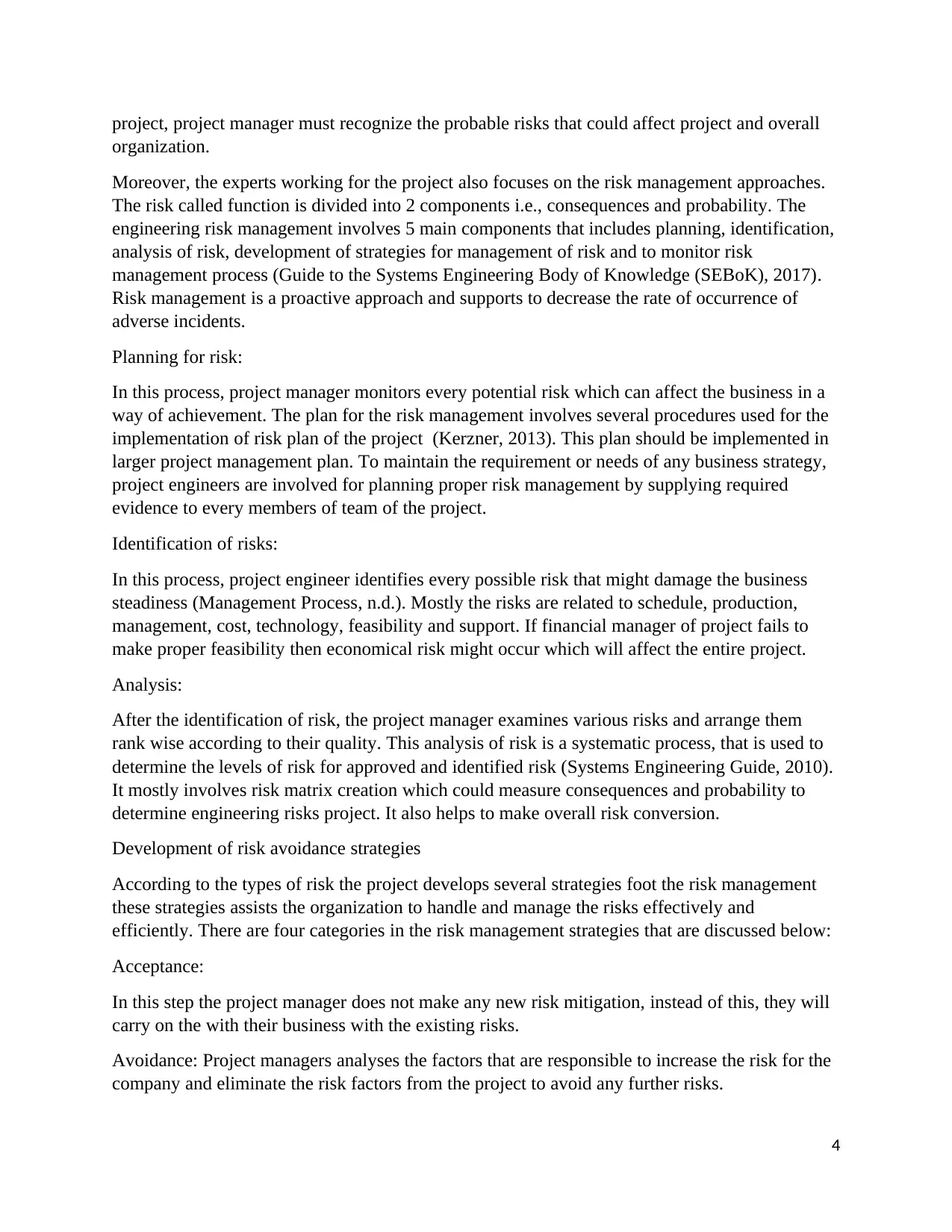
project, project manager must recognize the probable risks that could affect project and overall
organization.
Moreover, the experts working for the project also focuses on the risk management approaches.
The risk called function is divided into 2 components i.e., consequences and probability. The
engineering risk management involves 5 main components that includes planning, identification,
analysis of risk, development of strategies for management of risk and to monitor risk
management process (Guide to the Systems Engineering Body of Knowledge (SEBoK), 2017).
Risk management is a proactive approach and supports to decrease the rate of occurrence of
adverse incidents.
Planning for risk:
In this process, project manager monitors every potential risk which can affect the business in a
way of achievement. The plan for the risk management involves several procedures used for the
implementation of risk plan of the project (Kerzner, 2013). This plan should be implemented in
larger project management plan. To maintain the requirement or needs of any business strategy,
project engineers are involved for planning proper risk management by supplying required
evidence to every members of team of the project.
Identification of risks:
In this process, project engineer identifies every possible risk that might damage the business
steadiness (Management Process, n.d.). Mostly the risks are related to schedule, production,
management, cost, technology, feasibility and support. If financial manager of project fails to
make proper feasibility then economical risk might occur which will affect the entire project.
Analysis:
After the identification of risk, the project manager examines various risks and arrange them
rank wise according to their quality. This analysis of risk is a systematic process, that is used to
determine the levels of risk for approved and identified risk (Systems Engineering Guide, 2010).
It mostly involves risk matrix creation which could measure consequences and probability to
determine engineering risks project. It also helps to make overall risk conversion.
Development of risk avoidance strategies
According to the types of risk the project develops several strategies foot the risk management
these strategies assists the organization to handle and manage the risks effectively and
efficiently. There are four categories in the risk management strategies that are discussed below:
Acceptance:
In this step the project manager does not make any new risk mitigation, instead of this, they will
carry on the with their business with the existing risks.
Avoidance: Project managers analyses the factors that are responsible to increase the risk for the
company and eliminate the risk factors from the project to avoid any further risks.
4
organization.
Moreover, the experts working for the project also focuses on the risk management approaches.
The risk called function is divided into 2 components i.e., consequences and probability. The
engineering risk management involves 5 main components that includes planning, identification,
analysis of risk, development of strategies for management of risk and to monitor risk
management process (Guide to the Systems Engineering Body of Knowledge (SEBoK), 2017).
Risk management is a proactive approach and supports to decrease the rate of occurrence of
adverse incidents.
Planning for risk:
In this process, project manager monitors every potential risk which can affect the business in a
way of achievement. The plan for the risk management involves several procedures used for the
implementation of risk plan of the project (Kerzner, 2013). This plan should be implemented in
larger project management plan. To maintain the requirement or needs of any business strategy,
project engineers are involved for planning proper risk management by supplying required
evidence to every members of team of the project.
Identification of risks:
In this process, project engineer identifies every possible risk that might damage the business
steadiness (Management Process, n.d.). Mostly the risks are related to schedule, production,
management, cost, technology, feasibility and support. If financial manager of project fails to
make proper feasibility then economical risk might occur which will affect the entire project.
Analysis:
After the identification of risk, the project manager examines various risks and arrange them
rank wise according to their quality. This analysis of risk is a systematic process, that is used to
determine the levels of risk for approved and identified risk (Systems Engineering Guide, 2010).
It mostly involves risk matrix creation which could measure consequences and probability to
determine engineering risks project. It also helps to make overall risk conversion.
Development of risk avoidance strategies
According to the types of risk the project develops several strategies foot the risk management
these strategies assists the organization to handle and manage the risks effectively and
efficiently. There are four categories in the risk management strategies that are discussed below:
Acceptance:
In this step the project manager does not make any new risk mitigation, instead of this, they will
carry on the with their business with the existing risks.
Avoidance: Project managers analyses the factors that are responsible to increase the risk for the
company and eliminate the risk factors from the project to avoid any further risks.
4
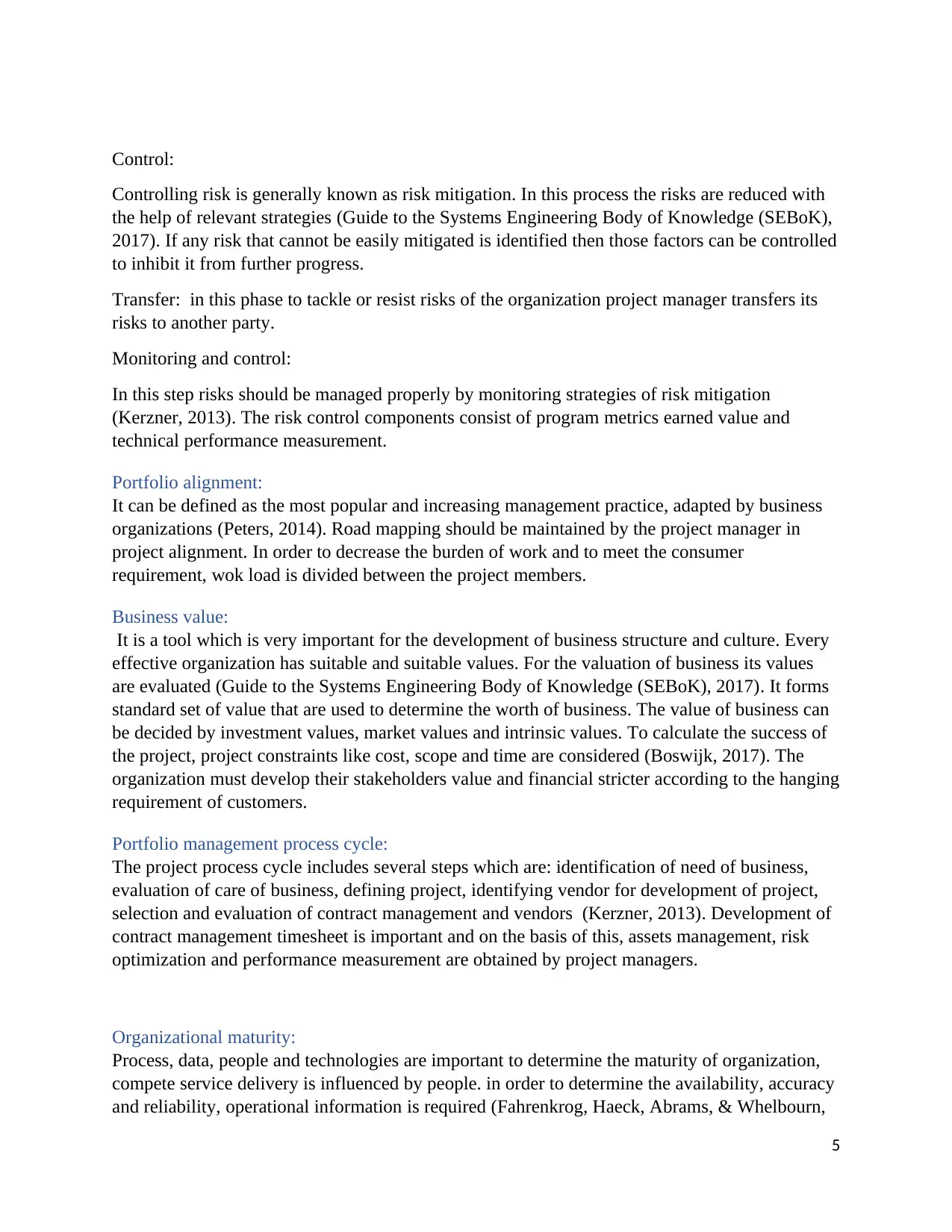
Control:
Controlling risk is generally known as risk mitigation. In this process the risks are reduced with
the help of relevant strategies (Guide to the Systems Engineering Body of Knowledge (SEBoK),
2017). If any risk that cannot be easily mitigated is identified then those factors can be controlled
to inhibit it from further progress.
Transfer: in this phase to tackle or resist risks of the organization project manager transfers its
risks to another party.
Monitoring and control:
In this step risks should be managed properly by monitoring strategies of risk mitigation
(Kerzner, 2013). The risk control components consist of program metrics earned value and
technical performance measurement.
Portfolio alignment:
It can be defined as the most popular and increasing management practice, adapted by business
organizations (Peters, 2014). Road mapping should be maintained by the project manager in
project alignment. In order to decrease the burden of work and to meet the consumer
requirement, wok load is divided between the project members.
Business value:
It is a tool which is very important for the development of business structure and culture. Every
effective organization has suitable and suitable values. For the valuation of business its values
are evaluated (Guide to the Systems Engineering Body of Knowledge (SEBoK), 2017). It forms
standard set of value that are used to determine the worth of business. The value of business can
be decided by investment values, market values and intrinsic values. To calculate the success of
the project, project constraints like cost, scope and time are considered (Boswijk, 2017). The
organization must develop their stakeholders value and financial stricter according to the hanging
requirement of customers.
Portfolio management process cycle:
The project process cycle includes several steps which are: identification of need of business,
evaluation of care of business, defining project, identifying vendor for development of project,
selection and evaluation of contract management and vendors (Kerzner, 2013). Development of
contract management timesheet is important and on the basis of this, assets management, risk
optimization and performance measurement are obtained by project managers.
Organizational maturity:
Process, data, people and technologies are important to determine the maturity of organization,
compete service delivery is influenced by people. in order to determine the availability, accuracy
and reliability, operational information is required (Fahrenkrog, Haeck, Abrams, & Whelbourn,
5
Controlling risk is generally known as risk mitigation. In this process the risks are reduced with
the help of relevant strategies (Guide to the Systems Engineering Body of Knowledge (SEBoK),
2017). If any risk that cannot be easily mitigated is identified then those factors can be controlled
to inhibit it from further progress.
Transfer: in this phase to tackle or resist risks of the organization project manager transfers its
risks to another party.
Monitoring and control:
In this step risks should be managed properly by monitoring strategies of risk mitigation
(Kerzner, 2013). The risk control components consist of program metrics earned value and
technical performance measurement.
Portfolio alignment:
It can be defined as the most popular and increasing management practice, adapted by business
organizations (Peters, 2014). Road mapping should be maintained by the project manager in
project alignment. In order to decrease the burden of work and to meet the consumer
requirement, wok load is divided between the project members.
Business value:
It is a tool which is very important for the development of business structure and culture. Every
effective organization has suitable and suitable values. For the valuation of business its values
are evaluated (Guide to the Systems Engineering Body of Knowledge (SEBoK), 2017). It forms
standard set of value that are used to determine the worth of business. The value of business can
be decided by investment values, market values and intrinsic values. To calculate the success of
the project, project constraints like cost, scope and time are considered (Boswijk, 2017). The
organization must develop their stakeholders value and financial stricter according to the hanging
requirement of customers.
Portfolio management process cycle:
The project process cycle includes several steps which are: identification of need of business,
evaluation of care of business, defining project, identifying vendor for development of project,
selection and evaluation of contract management and vendors (Kerzner, 2013). Development of
contract management timesheet is important and on the basis of this, assets management, risk
optimization and performance measurement are obtained by project managers.
Organizational maturity:
Process, data, people and technologies are important to determine the maturity of organization,
compete service delivery is influenced by people. in order to determine the availability, accuracy
and reliability, operational information is required (Fahrenkrog, Haeck, Abrams, & Whelbourn,
5
⊘ This is a preview!⊘
Do you want full access?
Subscribe today to unlock all pages.

Trusted by 1+ million students worldwide
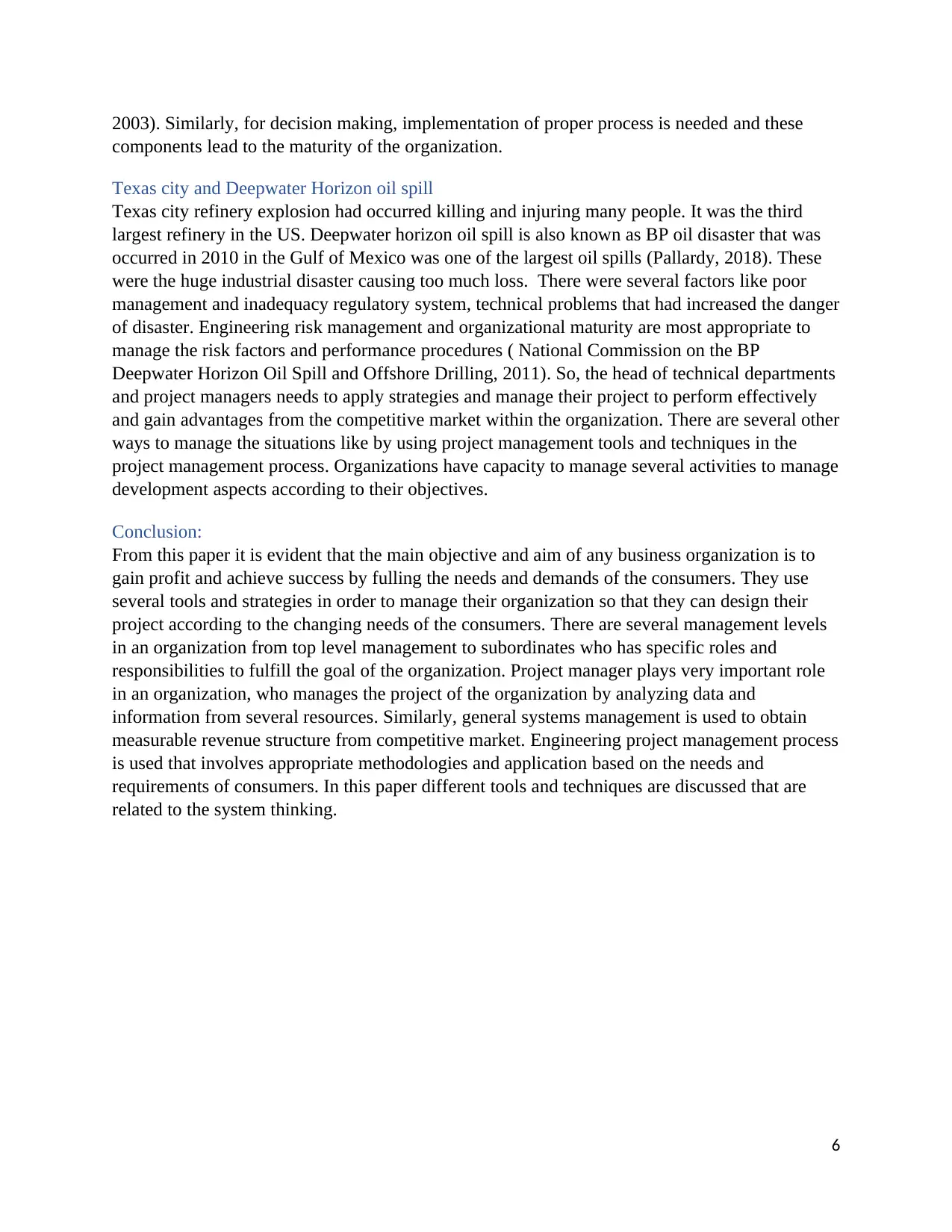
2003). Similarly, for decision making, implementation of proper process is needed and these
components lead to the maturity of the organization.
Texas city and Deepwater Horizon oil spill
Texas city refinery explosion had occurred killing and injuring many people. It was the third
largest refinery in the US. Deepwater horizon oil spill is also known as BP oil disaster that was
occurred in 2010 in the Gulf of Mexico was one of the largest oil spills (Pallardy, 2018). These
were the huge industrial disaster causing too much loss. There were several factors like poor
management and inadequacy regulatory system, technical problems that had increased the danger
of disaster. Engineering risk management and organizational maturity are most appropriate to
manage the risk factors and performance procedures ( National Commission on the BP
Deepwater Horizon Oil Spill and Offshore Drilling, 2011). So, the head of technical departments
and project managers needs to apply strategies and manage their project to perform effectively
and gain advantages from the competitive market within the organization. There are several other
ways to manage the situations like by using project management tools and techniques in the
project management process. Organizations have capacity to manage several activities to manage
development aspects according to their objectives.
Conclusion:
From this paper it is evident that the main objective and aim of any business organization is to
gain profit and achieve success by fulling the needs and demands of the consumers. They use
several tools and strategies in order to manage their organization so that they can design their
project according to the changing needs of the consumers. There are several management levels
in an organization from top level management to subordinates who has specific roles and
responsibilities to fulfill the goal of the organization. Project manager plays very important role
in an organization, who manages the project of the organization by analyzing data and
information from several resources. Similarly, general systems management is used to obtain
measurable revenue structure from competitive market. Engineering project management process
is used that involves appropriate methodologies and application based on the needs and
requirements of consumers. In this paper different tools and techniques are discussed that are
related to the system thinking.
6
components lead to the maturity of the organization.
Texas city and Deepwater Horizon oil spill
Texas city refinery explosion had occurred killing and injuring many people. It was the third
largest refinery in the US. Deepwater horizon oil spill is also known as BP oil disaster that was
occurred in 2010 in the Gulf of Mexico was one of the largest oil spills (Pallardy, 2018). These
were the huge industrial disaster causing too much loss. There were several factors like poor
management and inadequacy regulatory system, technical problems that had increased the danger
of disaster. Engineering risk management and organizational maturity are most appropriate to
manage the risk factors and performance procedures ( National Commission on the BP
Deepwater Horizon Oil Spill and Offshore Drilling, 2011). So, the head of technical departments
and project managers needs to apply strategies and manage their project to perform effectively
and gain advantages from the competitive market within the organization. There are several other
ways to manage the situations like by using project management tools and techniques in the
project management process. Organizations have capacity to manage several activities to manage
development aspects according to their objectives.
Conclusion:
From this paper it is evident that the main objective and aim of any business organization is to
gain profit and achieve success by fulling the needs and demands of the consumers. They use
several tools and strategies in order to manage their organization so that they can design their
project according to the changing needs of the consumers. There are several management levels
in an organization from top level management to subordinates who has specific roles and
responsibilities to fulfill the goal of the organization. Project manager plays very important role
in an organization, who manages the project of the organization by analyzing data and
information from several resources. Similarly, general systems management is used to obtain
measurable revenue structure from competitive market. Engineering project management process
is used that involves appropriate methodologies and application based on the needs and
requirements of consumers. In this paper different tools and techniques are discussed that are
related to the system thinking.
6
Paraphrase This Document
Need a fresh take? Get an instant paraphrase of this document with our AI Paraphraser
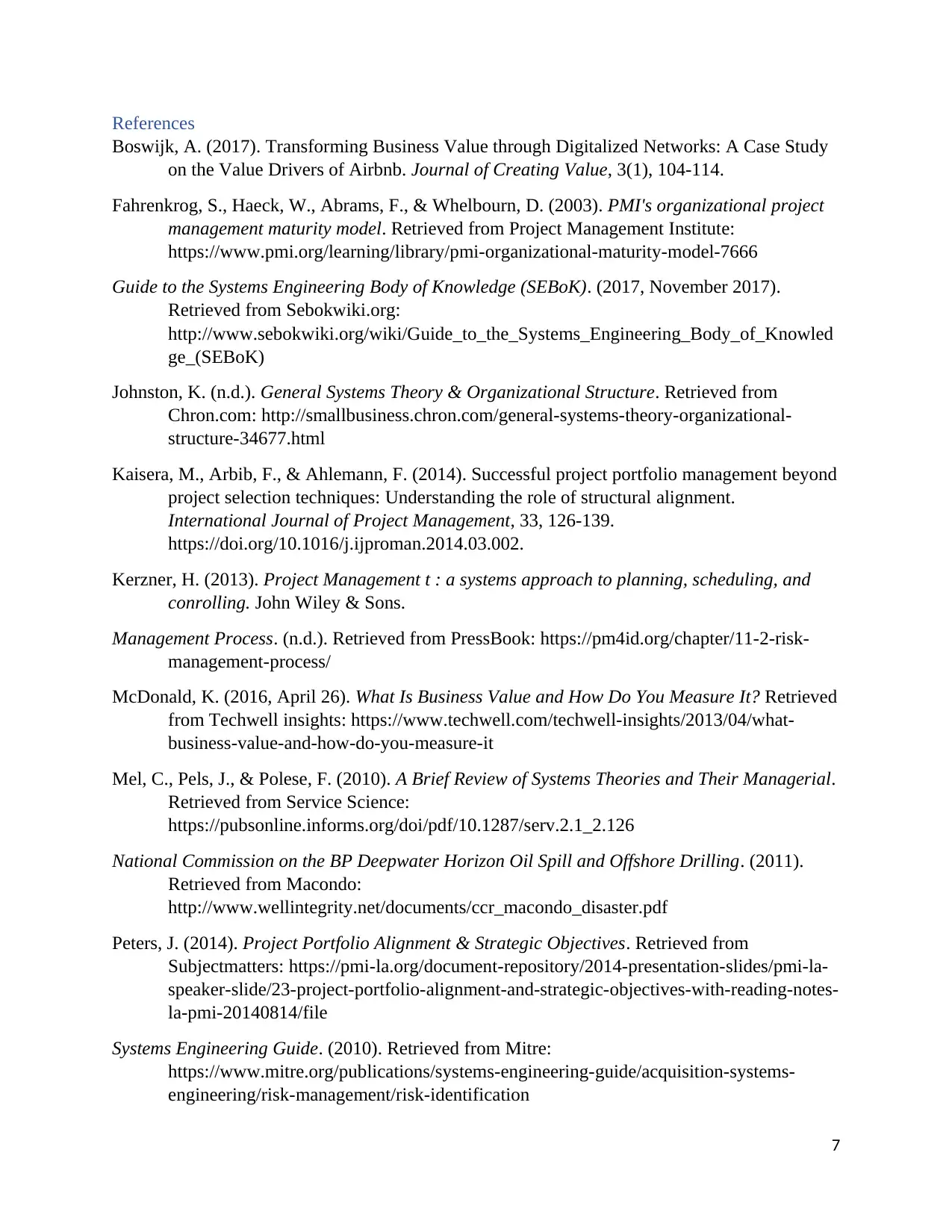
References
Boswijk, A. (2017). Transforming Business Value through Digitalized Networks: A Case Study
on the Value Drivers of Airbnb. Journal of Creating Value, 3(1), 104-114.
Fahrenkrog, S., Haeck, W., Abrams, F., & Whelbourn, D. (2003). PMI's organizational project
management maturity model. Retrieved from Project Management Institute:
https://www.pmi.org/learning/library/pmi-organizational-maturity-model-7666
Guide to the Systems Engineering Body of Knowledge (SEBoK). (2017, November 2017).
Retrieved from Sebokwiki.org:
http://www.sebokwiki.org/wiki/Guide_to_the_Systems_Engineering_Body_of_Knowled
ge_(SEBoK)
Johnston, K. (n.d.). General Systems Theory & Organizational Structure. Retrieved from
Chron.com: http://smallbusiness.chron.com/general-systems-theory-organizational-
structure-34677.html
Kaisera, M., Arbib, F., & Ahlemann, F. (2014). Successful project portfolio management beyond
project selection techniques: Understanding the role of structural alignment.
International Journal of Project Management, 33, 126-139.
https://doi.org/10.1016/j.ijproman.2014.03.002.
Kerzner, H. (2013). Project Management t : a systems approach to planning, scheduling, and
conrolling. John Wiley & Sons.
Management Process. (n.d.). Retrieved from PressBook: https://pm4id.org/chapter/11-2-risk-
management-process/
McDonald, K. (2016, April 26). What Is Business Value and How Do You Measure It? Retrieved
from Techwell insights: https://www.techwell.com/techwell-insights/2013/04/what-
business-value-and-how-do-you-measure-it
Mel, C., Pels, J., & Polese, F. (2010). A Brief Review of Systems Theories and Their Managerial.
Retrieved from Service Science:
https://pubsonline.informs.org/doi/pdf/10.1287/serv.2.1_2.126
National Commission on the BP Deepwater Horizon Oil Spill and Offshore Drilling. (2011).
Retrieved from Macondo:
http://www.wellintegrity.net/documents/ccr_macondo_disaster.pdf
Peters, J. (2014). Project Portfolio Alignment & Strategic Objectives. Retrieved from
Subjectmatters: https://pmi-la.org/document-repository/2014-presentation-slides/pmi-la-
speaker-slide/23-project-portfolio-alignment-and-strategic-objectives-with-reading-notes-
la-pmi-20140814/file
Systems Engineering Guide. (2010). Retrieved from Mitre:
https://www.mitre.org/publications/systems-engineering-guide/acquisition-systems-
engineering/risk-management/risk-identification
7
Boswijk, A. (2017). Transforming Business Value through Digitalized Networks: A Case Study
on the Value Drivers of Airbnb. Journal of Creating Value, 3(1), 104-114.
Fahrenkrog, S., Haeck, W., Abrams, F., & Whelbourn, D. (2003). PMI's organizational project
management maturity model. Retrieved from Project Management Institute:
https://www.pmi.org/learning/library/pmi-organizational-maturity-model-7666
Guide to the Systems Engineering Body of Knowledge (SEBoK). (2017, November 2017).
Retrieved from Sebokwiki.org:
http://www.sebokwiki.org/wiki/Guide_to_the_Systems_Engineering_Body_of_Knowled
ge_(SEBoK)
Johnston, K. (n.d.). General Systems Theory & Organizational Structure. Retrieved from
Chron.com: http://smallbusiness.chron.com/general-systems-theory-organizational-
structure-34677.html
Kaisera, M., Arbib, F., & Ahlemann, F. (2014). Successful project portfolio management beyond
project selection techniques: Understanding the role of structural alignment.
International Journal of Project Management, 33, 126-139.
https://doi.org/10.1016/j.ijproman.2014.03.002.
Kerzner, H. (2013). Project Management t : a systems approach to planning, scheduling, and
conrolling. John Wiley & Sons.
Management Process. (n.d.). Retrieved from PressBook: https://pm4id.org/chapter/11-2-risk-
management-process/
McDonald, K. (2016, April 26). What Is Business Value and How Do You Measure It? Retrieved
from Techwell insights: https://www.techwell.com/techwell-insights/2013/04/what-
business-value-and-how-do-you-measure-it
Mel, C., Pels, J., & Polese, F. (2010). A Brief Review of Systems Theories and Their Managerial.
Retrieved from Service Science:
https://pubsonline.informs.org/doi/pdf/10.1287/serv.2.1_2.126
National Commission on the BP Deepwater Horizon Oil Spill and Offshore Drilling. (2011).
Retrieved from Macondo:
http://www.wellintegrity.net/documents/ccr_macondo_disaster.pdf
Peters, J. (2014). Project Portfolio Alignment & Strategic Objectives. Retrieved from
Subjectmatters: https://pmi-la.org/document-repository/2014-presentation-slides/pmi-la-
speaker-slide/23-project-portfolio-alignment-and-strategic-objectives-with-reading-notes-
la-pmi-20140814/file
Systems Engineering Guide. (2010). Retrieved from Mitre:
https://www.mitre.org/publications/systems-engineering-guide/acquisition-systems-
engineering/risk-management/risk-identification
7
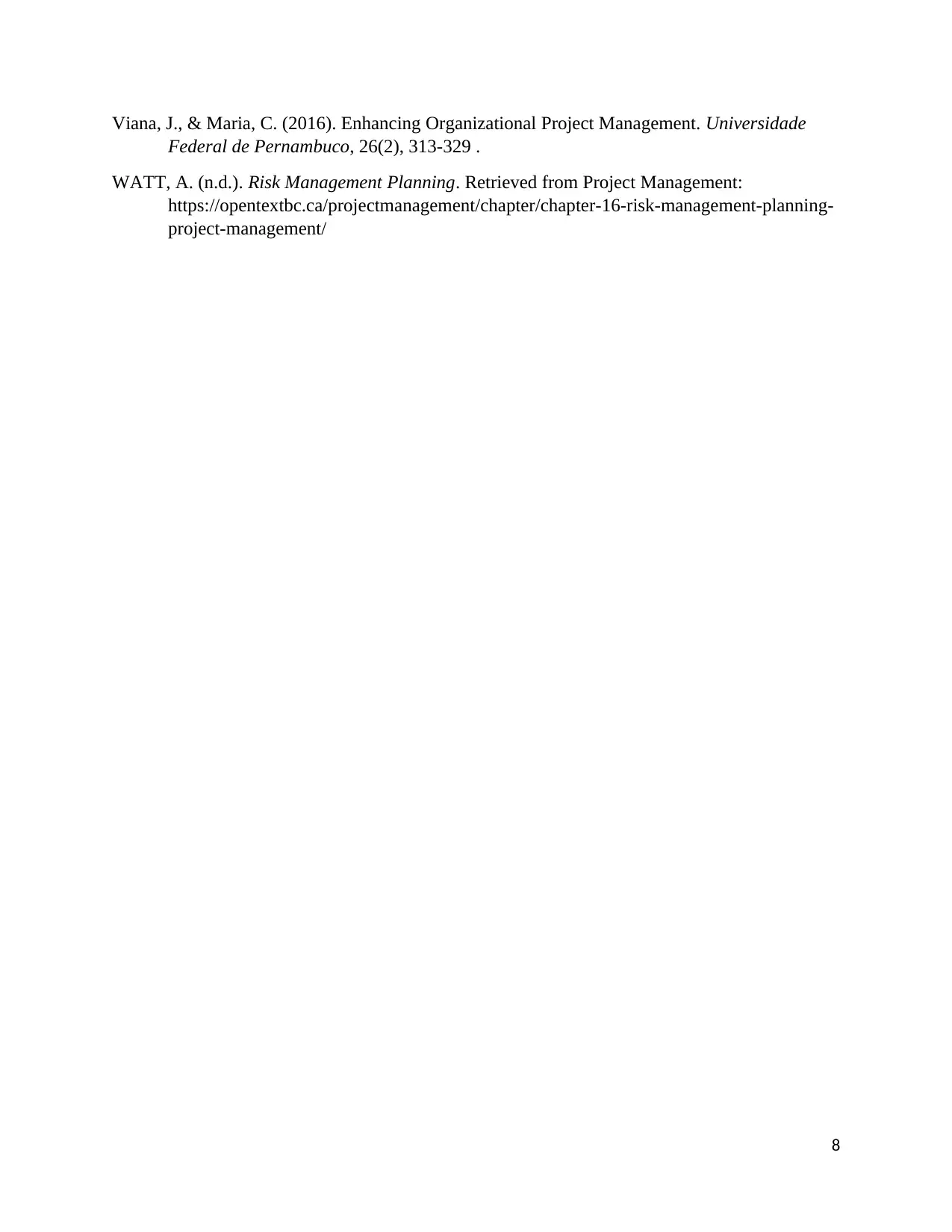
Viana, J., & Maria, C. (2016). Enhancing Organizational Project Management. Universidade
Federal de Pernambuco, 26(2), 313-329 .
WATT, A. (n.d.). Risk Management Planning. Retrieved from Project Management:
https://opentextbc.ca/projectmanagement/chapter/chapter-16-risk-management-planning-
project-management/
8
Federal de Pernambuco, 26(2), 313-329 .
WATT, A. (n.d.). Risk Management Planning. Retrieved from Project Management:
https://opentextbc.ca/projectmanagement/chapter/chapter-16-risk-management-planning-
project-management/
8
⊘ This is a preview!⊘
Do you want full access?
Subscribe today to unlock all pages.

Trusted by 1+ million students worldwide
1 out of 9
Related Documents
Your All-in-One AI-Powered Toolkit for Academic Success.
+13062052269
info@desklib.com
Available 24*7 on WhatsApp / Email
![[object Object]](/_next/static/media/star-bottom.7253800d.svg)
Unlock your academic potential
Copyright © 2020–2025 A2Z Services. All Rights Reserved. Developed and managed by ZUCOL.





